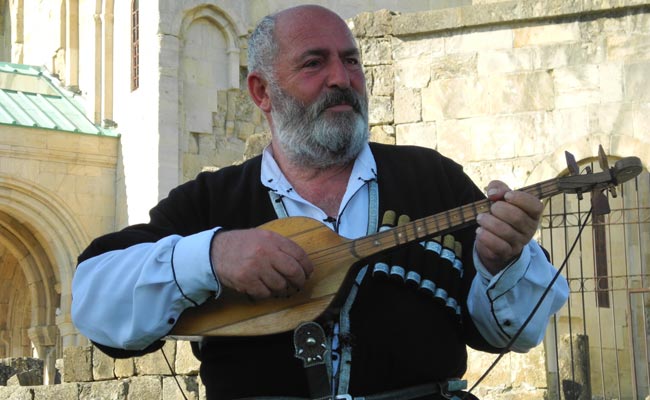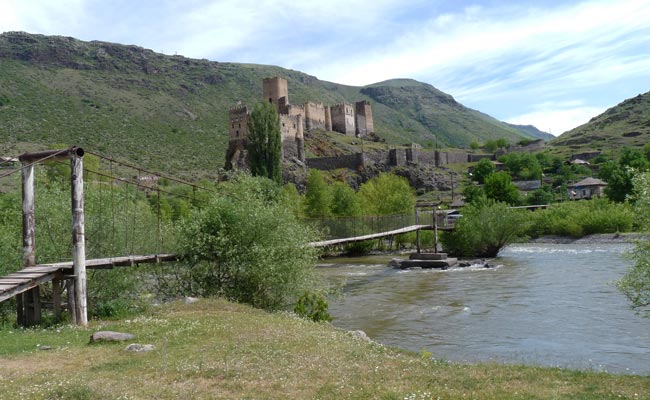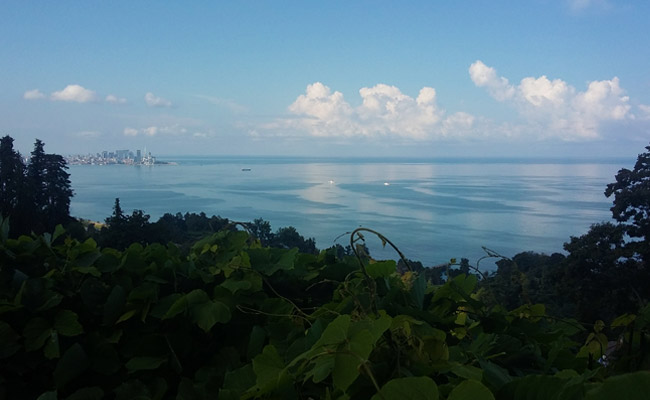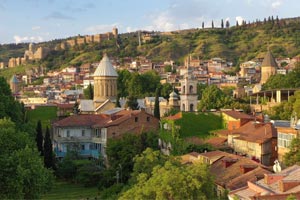|
Imereti The western Georgian administrative region of Imereti, with its capital Kutaisi, is in many ways a central part of Georgia, politically, economically, culturally, historically, artistically and literarily. From the 15th to the beginning of the 19th century, Imereti was independent and formed one of the three Georgian kingdoms. The famous epic poem of the Argonauts, written by Apollonius Rhodius in the 3rd century BC is linked to Imereti, and the ancient kingdom of Colchis existed here. This region is home to the famous Bagrati and Gelati cathedrals. The most popular Georgian poets, writers and composers come from Imereti: Akaki Tsereteli, Galaktion Tabidze, Zaqaria Paliashvili, Kote Marjanishvili and many others. Imereti has often played a decisive role in the history of the country, as it was the last bastion during the Ottoman and Persian invasions, where kings from other regions found refuge, and the ancient city of Kutaisi, now the administrative centre of the regions, served as the country's capital for several centuries. Most of the country's raw materials, such as coal and manganese ore, are mined in Imereti. The region also has a particularly balanced and varied cuisine and wine. All of Georgia is famous for its hospitality, but nowhere is it more passionately celebrated than in Imereti. You will always feel welcome in Imereti. General info Area: 6,680 sq km Structure of the administrative region Imereti is divided into twelve municipalities (administrative districts) named after their administrative centres. The region is administered by a governor who is appointed and dismissed by the Prime Minister of Georgia. There are 10 towns, 3 small towns (urban settlements) and 529 villages in the region. Cultural and natural highlights Imereti is very rich in cultural monuments, from ancient to medieval and modern times. The region also boasts varied and diverse landscapes, as well as several health resorts. Cultural monuments 1. Gelati Cathedral Scenic highlights 1. Okatse Gorge Spas 1. Zqaltubo Cuisine and regional specialities Unlike other regions, especially in the east of the country, Imereti's cuisine is based on white meat and a variety of vegetables. Here is a small selection of the most popular Imeretin specialities. 1. Kecis dedali - chicken roasted on a clay pan, marinated in garlic or mirabelle sauce Wine in Imereti Like the cuisine, the wines of Imereti are light and versatile. There are three different micro-zones and over 100 different grape varieties, most of which can only be found in Western Georgia. The method of winemaking in Imereti is similar to that of East Georgia, with wines pressed in underground amphorae, known in the West as churi rather than qwewri. Unlike in the east, the wine ferments together with only a small amount of mash. This gives the wine its lightness, preserves the aromas of the grapes and is less dominated by tannins. In Imereti it is mainly white wines that are drunk and the most popular are: 1. Tsolikouri - dry and fruity white wine made from the late ripening autochthonous grape of the same name. Regional festivals and traditions In Georgia in general, but especially in Imereti, there are many festivals. Each town has its own festival, such as Kutaisoba (Kutaisi), Khoneloba (Khoni), Zestafonoba (Zestafoni), etc. During these festivals, the foundation of the respective towns is celebrated and several concerts with regional folklore take place. The Zekaroba festival of friendship is remarkable. This festival takes place every year in August at the Zekari Pass at an altitude of about 2,200 metres. The pass connects two regions, Samtskhe and Imereti. Background: Throughout history, there have been many tensions between the two regions, as Samtskhe was under Ottoman rule for several centuries and the threat to Imereti came mainly from this region. As a symbol of reconciliation and friendship, the festival has been celebrated by both regions for several decades. Samkhto Tsirva - This is not a folk festival but a regional tradition that could be translated as 'family liturgy'. There is no fixed date for the festival, but at least once a year the whole family gathers around the wine amphora and prays for bread, wine and divine blessings. Special dishes are prepared for the day: Bread stuffed with nine different vegetables, roasted and boiled chicken and cheese rolls. The whole meal is laid out at the amphora, followed by the lighting of candles and kneeling prayers around the wine amphora. Finally, the wine amphora is opened and there is a celebration and praise to God. Flora and fauna A very large part of the region, 250,000 hectares, consists of forest, of which 24,000 hectares are National Park. Most of the forest in the region is mixed, but coniferous forest can be found here and there. By Georgian standards, Imereti is relatively low, with the highest point at 2,850 metres and the lowest at about 20 metres. Of the wildlife that lives in the forests: Caucasian brown bear, wild boar, deer, fox, wolf and golden jackal. The largest rivers in Imereti are: Rioni with 327 km and Qwirila with 140 km. The climate The climate in Imereti is humid subtropical. The minimum temperature in winter is about + 1 and the maximum temperature in summer is + 35 to + 40 degrees Celsius. The average rainfall is 900 to 1600 mm. History of Imereti in brief The first Palaeolithic finds in the Caucasus were made in 1914 in the karst cave of Sakajia, in the area of present-day Imereti. There are also several Upper Palaeolithic and Mousterian (Middle Palaeolithic) sites in the region. The temple city of Vani, with its richly decorated rock tombs and precious metal graves dating from the 8th to 4th centuries BC, is evidence of an enormously advanced civilisation on the territory of Imereti. An optimal strategic and geographical position, fertile lands and gold mining led to the establishment of a powerful kingdom with its capital in Kutaisi in the 7th century BC. Colchis had good trade relations with the ancient Persian Empire and Greece and played a leading role in the region. An important branch of the Silk Road, linking the Orient with the West, also passed through the kingdom. After the Romans came into the picture in the 1st century, Colchis had to give up its leading role after several defeats at the hands of the great empire, and the kingdom of Egrisi, also called Lazika, was established on the territory of Colchis. The New Kingdom was largely vassal to Byzantium, but was able to maintain its identity and independence because it was important for Byzantium to have a strong partner on its side against the Persian wars. Byzantium-backed Bagrationi princes from southern Georgia managed to unite Georgia in the 10th century, and the capital of unified Georgia became Kutaisi, the present-day administrative centre of the region. (Tbilisi and its environs were in Arab hands at the time). The first king of united Georgia to be crowned in Kutaisi was Bagrat III of the Bagrationi dynasty, who ruled the country for about 1000 years. Georgia's greatest king, Dawit the Builder, was also crowned in Kutaisi in 1089. Among other things, Dawit managed to liberate Tbilisi from the Arabs and moved the capital and royal residence from Kutaisi to Tbilisi. After the Mongol invasions at the end of the 13th century, Georgia was divided into two parts, East and West Georgia. The background to the division of the country was the well-known principle of "divide et impera" (divide and conquer). At the time, the country was ruled by the Mongols, who installed the elder grandson of the famous Queen Tamara, Dawit Ulu, as king of East Georgia, and his cousin, Dawit Narini, from the Bagrationi dynasty, as king of the West. The Western Georgian kingdom was named Imereti and included the present-day historical regions: Svaneti, Samegrelo, Guria, Racha and the region of Achara on the Black Sea coast. It was not until the early 16th century, after Imereti had been weakened by Ottoman raids and internal unrest, that the aforementioned regions declared themselves independent kingdoms. Imereti under Tsarist Russia Over the centuries there were attempts to unite with other Georgian kingdoms, and sometimes they succeeded, but Persia on the one hand and the Ottoman Empire on the other did not give Georgia a chance to really get on its feet. As a result, in the early 19th century, Imereti became a protectorate of Russia and was soon incorporated into the Tsarist Empire in 1810. A good 100 years under Tsarism were marked by uprisings and unrest, but there was also great progress in agriculture, education, health and so on. But the Georgians could not get used to being annexed, and soon after the October Revolution, Georgia declared its independence. Imereti and its capital, Kutaisi, played an important role in this, as Kutaisi was considered a cultural centre and a meeting place for artists from different fields. In 1918, Kutaisi and the whole of Imereti, as well as all the other regions of the country, became a unified state, the first Georgian Republic, with an elected parliament and a constitution that, among other things, confirmed women's suffrage. The new republic was recognised not only by Europe but also by Russia, but this did not prevent the Bolsheviks from occupying Georgia in 1921. The Soviet era After several uprisings against the Soviet regime and state repression, but especially after the Second World War, large-scale industrialisation began in the region. Imereti's raw materials, coal and manganese, played a key role. Several factories were built in and around Kutaisi to process raw materials and manufacture machinery. Imereti, and especially Kutaisi, became a real industrial city, where people worked a lot and earned little, but that was the norm under communism. Imereti after Georgia's independence The collapse of the Soviet Union was very painful for the region, as all the factories were closed, pensions were cut and the money saved in the bank account was worth nothing due to inflation. It took several years for Imereti to get back on its feet. After about 15 years of independence, Imereti was back to normal. Car workshops were opened, raw materials were mined again, and agriculture was once again run by small farmers. In 2012, the parliament was moved to Kutaisi in an attempt to decentralise the country and bring Imereti back to life, but the project didn't work out so well and the parliament was moved back to Tbilisi in 2019. Today, tourism is an important economic sector in the region, along with industry and agriculture. On following trip you will visit Imereti:
from 1.690 EUR |






